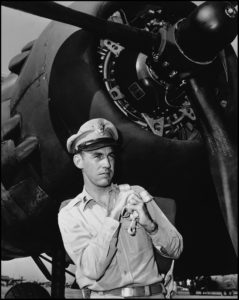
Richard E. Cole
Doolittle Raider
Richard E. Cole
Lieutenant Colonel, Army Air Corps, Ret.
1940–1963

Lt. Richard E. Cole,
Riverside, CA, 1941
I was Jimmy Doolittle’s co-pilot during the raid on Tokyo, April 18th, 1942.
I was born September 7, 1915 and raised in Dayton, Ohio. As a young kid, I used to ride my bicycle from where we lived three or four miles to McCook Field, the Army Air Corps’ first test base. I got to watch all the old-timers. I graduated from Steele High School in Dayton in the middle of the Depression. I had made up my mind I was going to be a pilot or a forest ranger, and completed two years college at Ohio University.
I enlisted in the Army Air Corps on November 22, 1940, completed pilot training and was commissioned as a second lieutenant. After the Japanese attacked Pearl Harbor, President Roosevelt wanted an attack on the Japanese mainland as soon as possible. The Emperor had told the Japanese people that they would never be attacked, as Japan was too far from America. Captain Francis Low had the idea of bombers taking off from an aircraft carrier. An outline of an aircraft carrier was drawn on the tarmac. On January 31, 1942 two successful practice runs showed that it could be done. I saw a notice on the squadron bulletin board that they wanted volunteers for a mission. I volunteered.
Lt. Col. James Doolittle was to plan the attack on Japan and fly plane number 1. I was fortunate to be his co-pilot. The normal takeoff with the B-25 loaded was somewhere around 3,000 feet. We had to be airborne in 500 feet. We set sail on the USS Hornet from San Francisco on April 2, 1942 with 16 B-25 Mitchell bombers, each with a crew of five.
The plan was to take off 450 miles from the Japanese coast, drop our bombs and land at airfields in China that were controlled by friendly forces. When the Hornet was detected by a Japanese ship, Doolittle decided to launch the bombers 200 miles from the planned start point. The chances of us reaching airfields in western China were slim. We flew 200 feet above the ocean to avoid radar detection. It was a bright, sunny day and people were out on the beach. Nobody seemed to care when they saw us. The Japanese had an airplane called a “Nell” that looked something like a B-25, and we think they thought we were one of theirs.
After bombing Tokyo, we did make it to China, but were short of our destination and had to bail out. The weather was bad with moderate to heavy rain. I pulled the rip cord so hard I gave myself a black eye. My parachute got caught in a pine tree and, as it was a pitch-black night, I decided to stay in the tree until daybreak. I spent the night about 12 feet off the ground in the rain and wind. I later made it to the village of Chiu Chow, where Chinese patriots helped us.
Worst day in the Army Air Corps—April 18, 1942 when I had to bail out over China in the dark. Best day in the Army Air Corps—April 18, 1942 when my parachute opened.
I was in the China-Burma-India theater from 1943 to 1944. From 1959-1962 I was an operations advisor to the Venezuelan Air Force. In 1963 I retired and went into the citrus business in South Texas and was the first to put avocados there.
Decorations include Distinguished Flying Cross with 2 Oak Leaf Clusters, Air Medal with 1 Oak Leaf Cluster, Bronze Star Medal, Air Force Commendation Medal, and Chinese Army, Navy, Air Corps Medal, Class A, 1st Grade.
On September 7, 2018 I will be 102 years old. I am the last surviving member of the 80 Doolittle Raiders. I wrote a book a book about my experiences Dick Cole’s War. {09-26-2018 • Fredericksburg, TX}